Abstract
OBJECTIVE: To determine the clinical utility of a new age-adjusted measure of body fat distribution (based on waist and hip circumferences) and stature, in relation to biochemical complications in obese children.
DESIGN: Cross-sectional, clinical study. The formula to calculate the common standard deviation score (SDS) of waist-to-hip ratio/height (WHR/Ht) was obtained from the data of control children. The relationship between WHR/Ht SDS, as the age-adjusted measure, in obese children and their clinical laboratory data was evaluated.
SUBJECTS: Outpatient obese Japanese children (102 boys and 75 girls) and control children (508 boys and 549 girls), ranging in age from 6–15 y.
MEASUREMENTS: Height, body weight, waist girth, hip girth, triceps and subscapular skinfold thicknesses, as anthropometric measures. Percent overweight, percent body fat, waist girth, WHR and WHR/Ht SDS as criteria for obesity. Clinical laboratory analyses for fasting blood samples of obese children.
RESULTS: The WHR/Ht SDS closely correlated with age in obese children, thus reflecting the progress of abdominal obesity during growth. The obese boys were more hyperlipidaemic than the girls were, although the percent overweight was similar in both genders. The percent overweight, percent body fat, waist girth and WHR/Ht SDS all correlated well with triglyceride (TG), alanine aminotransferase (ALT) and insulin in boys, whereas only waist girth and WHR/Ht SDS showed a close correlation with TG and insulin in girls. The obese subjects were subdivided according to the number of abnormal values observed in TG, ALT and insulin. For obese boys, all five indices of obesity were higher in the groups with complications than in the group without. In the girls, only the WHR/Ht SDS constantly differed between subgroups. WHR/Ht SDS most obviously distinguished the groups with complications from the other group with a wide margin of difference (2-fold in boys and >2 -fold in girls) in the mean values.
CONCLUSION: The WHR/Ht SDS can serve as an index predicting the occurrence of biochemical complications in obese children ranging from the age of 6–15 y.
This is a preview of subscription content, access via your institution
Access options
Subscribe to this journal
Receive 12 print issues and online access
$259.00 per year
only $21.58 per issue
Buy this article
- Purchase on Springer Link
- Instant access to full article PDF
Prices may be subject to local taxes which are calculated during checkout
Similar content being viewed by others

Author information
Authors and Affiliations
Rights and permissions
About this article
Cite this article
Asayama, K., Hayashi, K., Hayashibe, H. et al. Relationships between an index of body fat distribution (based on waist and hip circumferences) and stature, and biochemical complications in obese children. Int J Obes 22, 1209–1216 (1998). https://doi.org/10.1038/sj.ijo.0800748
Received:
Revised:
Accepted:
Published:
Issue Date:
DOI: https://doi.org/10.1038/sj.ijo.0800748
Keywords
This article is cited by
-
Waist-to-height ratio is more closely associated with alanine aminotransferase levels than body mass index and waist circumference among population-based children: a cross-sectional study in Japan
BMC Pediatrics (2015)
-
Adiposity Gain During Childhood, ACE I/D Polymorphisms and Metabolic Outcomes
Obesity (2008)
-
Association between stunting and overweight among 10–15-y-old children in the North West Province of South Africa: the THUSA BANA Study
International Journal of Obesity (2004)
-
Decrease in Serum Adiponectin Level Due to Obesity and Visceral Fat Accumulation in Children
Obesity Research (2003)
-
Threshold values of visceral fat measures and their anthropometric alternatives for metabolic derangement in Japanese obese boys
International Journal of Obesity (2002)


